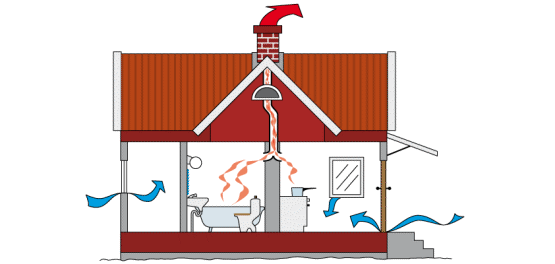Natural draught ventilation
A house with a natural draught ventilation system has no fan, and the air is admitted instead through valves and gaps in the structure and is discharged through ventilation ducts often built into the chimney breast.

The natural draught system is based on fresh air being drawn in through gaps and leakages in the house. The polluted room air flows out through the duct in the chimney breast and the exhaust air duct from the kitchen and bathroom. Illustration: Bo Reinerdahl
Air circulation is achieved by the temperature difference between the outdoor and indoor air. A natural draught system performs best in the winter when the temperature differences between outdoors and indoors are high.
The chimney breast is the heart of the house
The performance of a natural draught system also depends on how the house is used. The chimney breast is the heart of the house and performs an important function for ventilation in a house with natural draught ventilation. The heat stored in the chimney breast when a boiler, furnace or fireplace is fired helps to drive the ventilation, as does the quantity of oxygen needed for the fuel to burn. If the heating system is changed to a heat pump or district heating, ventilation problems may arise. This must be borne in mind so that no moisture and poor indoor climate problems will arise.
Advantages and disadvantages
The natural draught system is silent and insensitive to power cuts. However, it may cause poor ventilation in single-storey houses, and there is risk of reverse flow and draughts at the outdoor air registers. In a natural draught system, the heat in the exhaust air cannot be recovered.
Boosted ventilation
You can boost a natural draught ventilation system by installing a fan controlled by the outdoor air temperature. The fan will start when the temperature is more than 10°C, for instance, and the ventilation will then perform well even at low temperature differences between outdoors and indoors.


